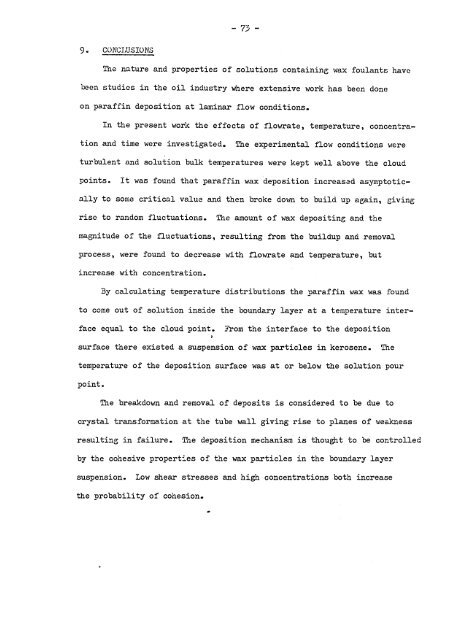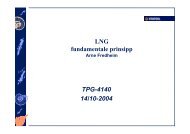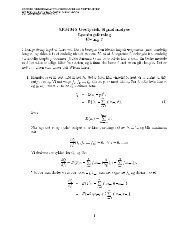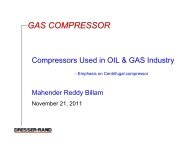- Page 1 and 2:
1 ci 0 Ilc (i) s_ri P4 4) •,-1 0
- Page 3 and 4:
ACKC’bJLED3E.:ENTS should like to
- Page 5 and 6:
46 iixperimental Results 461 IntroJ
- Page 7 and 8:
APPNNDICES 1. PHYSICal PRSPHTIES Oi
- Page 9 and 10:
the major unresolved problem in hea
- Page 11 and 12:
and time, fouling factors are usual
- Page 13 and 14:
o F-I 0 U J ,ij cn J ‘I—I F3 Fl
- Page 15 and 16:
—5— vary from less than 1 per c
- Page 17 and 18:
2.2.3 Solubility refined paraffin w
- Page 19 and 20:
-.9— whica is well novc condition
- Page 21 and 22:
— -ii — deposit. Tronov statej
- Page 23 and 24:
— 13 remain in solution and the p
- Page 25 and 26:
- iuctoov and dorov concluded hat t
- Page 27 and 28:
— 17 — a deporsiion ce:Ll in a
- Page 29 and 30:
— 19 - toat sur:ace. hjsima.a ot
- Page 31 and 32:
— 2 - S * .. -, ‘.: ,- - .-,-
- Page 33 and 34:
and surface proueriez reapectlvely_
- Page 35 and 36:
- 25 - loading to a random process
- Page 37 and 38:
y - F’J CD:’ C) x— Dcpoit thi
- Page 39 and 40:
0 C 15O— 200 From ref 2 of wax eo
- Page 41 and 42:
0 o3 Tb 3D 0•0 L D 2 •O— Fg.2
- Page 43 and 44:
2 I In 0 Tot -D -D U 16H 16 20, In
- Page 45 and 46:
C CE) CL) CE) () .: rJ\: - . c: CD
- Page 47 and 48:
400 function of roughness factor. m
- Page 49 and 50:
— 2o — 3. i3:\CGRDU ND TO TI PR
- Page 51 and 52:
3.5 Conclusions decreases At the in
- Page 53 and 54:
L - A sz: CF Fo:;:NG BY SOLUTIONS O
- Page 55 and 56:
was designed to cut off the steam s
- Page 57 and 58:
• saLLy measures were tacen. oa:D
- Page 59 and 60:
— 34 .4 ‘mrii:ntal Solution The
- Page 61 and 62:
sections were ke-:t the same. fosi:
- Page 63 and 64:
sectaon 4- at eajt tests sections h
- Page 65 and 66:
These fluctuations were not reduced
- Page 67 and 68:
ii ID XXX 9 C-) 0 (N x S x xx< 7r-
- Page 69 and 70:
12— -; 11L. s 10E - 9: ‘3) 0 Ru
- Page 71 and 72:
(1) U) C’) C) Cl) It) 0 0 0 0 ox
- Page 73 and 74:
f-iq. 1.0-3.5.— Hecit trcinsfcr r
- Page 75 and 76:
I--i Fig. f.6.3.7. I ;ut transfer r
- Page 77 and 78:
0 C’) R — [feat transfer resist
- Page 79 and 80:
characteristc does exist and is tyt
- Page 81 and 82:
The ziuewor in the circulation syst
- Page 83 and 84:
The calibrations o the tesperature
- Page 85 and 86:
the solution and water o::a;es thro
- Page 87 and 88:
‘-- 5,5 wocrinentsl Resuts with f
- Page 89 and 90:
two hours, the deposits were observ
- Page 91 and 92:
wcr: on ara:zic: c.eposc.tion consi
- Page 93 and 94: -- II 1 L1 SOLUIIOIJ C;IFCU1_/:[ION
- Page 95 and 96: SCAR FE 1 DEPOSITION PLATE - - 0 C)
- Page 97 and 98: M—AMOUNI DEPOSITED (mg) T1 0_i c)
- Page 99 and 100: C) 0 0 0 Li.] CD - 3 0 3 0 h Iii (E
- Page 101 and 102: - II -fl M—AMOUNT DEPOSITED (rng)
- Page 103 and 104: 91 9) :< C) --z 9] mc-) .;J -i ru
- Page 105 and 106: .1 1• ci E 0 Ci) c) — nj
- Page 107 and 108: - . O, O, I— —,-, fouling studi
- Page 109 and 110: profiles at different Reynolds numb
- Page 111 and 112: L Run . (°c) used to calculate tem
- Page 113 and 114: Due to a concentration gradient the
- Page 115 and 116: 1 I C. (1.2.2.2 \1L. I .OC[FY V [A[
- Page 117 and 118: V 40 - 0 C—, lt! -— o. ---—-
- Page 119 and 120: Li FIG. G.2.3./. TEMPERAI URE v RAD
- Page 121 and 122: — 1 7.0 0 --Tc.=10.0°C 50 140
- Page 123 and 124: — -- — -——— — -—Tb =
- Page 125 and 126: Z_o_—o-- 50 l0 - yX—--X— —-
- Page 127 and 128: I:302 00 50 Ito -0——— ---—-
- Page 129 and 130: I 50 ;) 30c’/ / C —------------
- Page 131 and 132: FIG. 6. 4.1. AN IDEEAL TEMPERATURE
- Page 133 and 134: — 63 — 7. DISCUSSIOI 7.1 Introd
- Page 135 and 136: — 65 — through it decreases gra
- Page 137 and 138: For breakdown and removal to occur
- Page 139 and 140: — 69 — the large fouling studie
- Page 141 and 142: Increased flowrate and temperature
- Page 143: — 72 — 8. ICOi’NDATTCNS It is
- Page 147 and 148: :0 e = Roughness factor Cp = Heat c
- Page 149 and 150: + = Average velocity at centre of t
- Page 151 and 152: Siid
- Page 153 and 154: 17. Nazee, W.M., “Modern Petroleu
- Page 155 and 156: — 81 — 46. Coulson, J., Richard
- Page 157 and 158: i S-i Ti .1” 0 -P -‘‘ •) 0
- Page 159 and 160: — - 5 The viscosity of paraffin w
- Page 161 and 162: — A5 — ..-6 ThD-1 DQactiv1r Thc
- Page 163 and 164: (:) rr 0 Ill U, . CD
- Page 165 and 166: 0 : 0 4-) ri () 0 (‘C 0 “C C’
- Page 167 and 168: — A9 — Table Ai.2.4 Cloud and o
- Page 169 and 170: — A91 — parafi’in w, it was a
- Page 171 and 172: )< 0 0 -H rn rn t - >< rn — o m F
- Page 173 and 174: The pressure transducer was calibra
- Page 175 and 176: — A16 —. Table P.3.2 Pressure t
- Page 177 and 178: - AlS - Table A33.2 Calibiation con
- Page 179 and 180: C C PROGRtt’ NAMF TUEEX J.S.GUOMU
- Page 181 and 182: C C 0 11 = 1K I — T D T 2 -=1K o
- Page 183 and 184: 11.17 7.40 7.65 34.30 33.50 9.5 0.6
- Page 185 and 186: RUN Aq-3 TIME ThI T0 TKI TKC DPK CP
- Page 187 and 188: RUN AIC—’i TIME TWI TC TKI TKC
- Page 189 and 190: 11.03 8.8C 9.8C 43.40 42.00 6.3 0.5
- Page 191 and 192: TINE ThI TWO TKI TKO 00K CPU OPT V
- Page 193 and 194: 16.08 6.6C 8.2C 44.60 42.80 25.5
- Page 195 and 196:
. 13.92 6.7C 7.cC ‘t2.8C 41.30 19
- Page 197 and 198:
42.15 6.4C 7.CC 42.80 41.00 7.3 1.0
- Page 199 and 200:
RUN C1—14 TIME TWI TWO TKI TKC DP
- Page 201 and 202:
RUN C2—15 TIME TiI TWO TK! TKC DP
- Page 203 and 204:
RUN C3—lé TIME TI TiC TKI TKO OP
- Page 205 and 206:
13.08 6.50 7.70 38.0 37.40 1.1.5 0.
- Page 207 and 208:
TIME TWI TC TKI TKC DPK CPW OPT V C
- Page 209 and 210:
163.17 6.50 7.C 38.OG 37.’0 9.0 0
- Page 211 and 212:
163.25 6.50 7.1C 38.70 37.30 3.8 0.
- Page 213 and 214:
RUN C1C—21 TIME ThI TWO TKJ TKO D
- Page 215 and 216:
RUN D1C—22 TIME TWI TC TKI TKC OP
- Page 217 and 218:
against a standard thermometer, was
- Page 219 and 220:
— A22 — Table A5.1 Calibration
- Page 221 and 222:
( C) setting Terorature Controller
- Page 223 and 224:
— A26 — APPENDIX 6 EXPEPINENTAL
- Page 225 and 226:
— A28 — Table A6.3 Th.n D2 Time
- Page 227 and 228:
-. A30 — Table A65 Iun D4 Time (m
- Page 229 and 230:
anoieter Flowrate — A32 — Table
- Page 231 and 232:
L U e;rression: / be used. diffusiv
- Page 233 and 234:
— A36 — A74 Velocity Distributi
- Page 235 and 236:
= y y + by iteration. dy’ + (2) C
- Page 237 and 238:
—A40— A8.2.5 Calculation of Phy
- Page 239 and 240:
— A42 — To evaluate equation f7
- Page 241 and 242:
30 - A44 — 85 Cornouter Calculati
- Page 243 and 244:
2 2.00 27 12.93 74 I 15.73 1 1.00 2
- Page 245 and 246:
C C C C GOTO 60 0 UtP=UP’USTAR Y=
- Page 247 and 248:
C C C. SUPROUTINE FF L11:NS1C’N F
- Page 249 and 250:
..RIT2(6,%0) VLSR,VISBS1 50 EORAT(1
- Page 251 and 252:
C C C C C C SUROUTIE FLUX REAL L,Lt
- Page 253 and 254:
- V C C .URPUrINE UPROF DLMNSIQN FY
- Page 255 and 256:
C C C SJtcLiJTINE TPC1F C LIfr:NSIL
- Page 257 and 258:
INPUT DATA AND FRICTION FACTOR TKI
- Page 259 and 260:
YP UP TP Y U T VIS rc CP PR 1.00 1.
- Page 261:
VP UP TP Y U T VIS TC CP PR 77.00 1
















